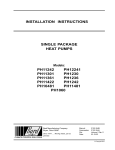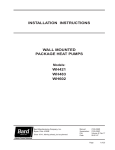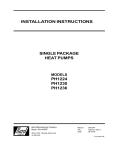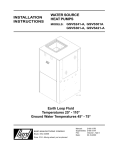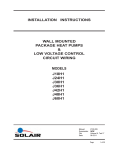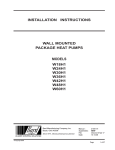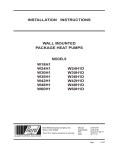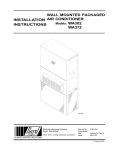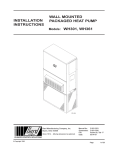Download Bard WH482 Specifications
Transcript
INSTALLATION INSTRUCTIONS WALL MOUNTED PACKAGE HEAT PUMPS MODELS: WH421 WH482 WH602 BARD MANUFACTURING COMPANY Bryan, Ohio 43506 Since 1914...Moving ahead, just as planned. Manual: Supersedes: File: Date: 2100-219M 2100-219L Volume III Tab 17 02-12-00 Copyright 2001 CONTENTS Getting Other Information and Publications .......... 1 For more information, contact these publishers: ...... 1 Wall Mount General Information ............................. Air Conditioner Wall Mount Model Nomenclature ..... Shipping Damage .................................................... General ............................................................... Duct Work ............................................................... Filters ............................................................... Fresh Air Intake ........................................................ Condensate Drain .................................................... 2 2 5 5 5 5 6 6 Installation Instructions ........................................... 7 Wall Mounting Information ....................................... 7 Mounting the Unit ..................................................... 7 Typical Installations .................................................. 7 Wiring – Main Power ............................................. 11 Wiring – Low Voltage Wiring ................................. 11 Thermostat Wiring ................................................. 12 Heat Anticipation .................................................... 12 Thermostat Indicator Lamps .................................. 13 Emergency Heat Position ...................................... 13 Compressor Malfunction ........................................ 13 Figures Figure 1 Figure 2 Figure 3 Figure 3A Figure 4 Figure 5 Figure 6 Figure 7 Figure 8 Unit Dimensions ..................................... 3 Blower Damper Assembly ...................... 6 Mounting Instructions .............................. 8 Electric Heat Clearance ......................... 8 Wall-Mounting Instructions ..................... 9 Wall-Mounting Instructions ..................... 9 Common Wall-Mounting Instructions .... 10 Unit 24V Terminal Board ....................... 11 Compressor Cutoff and Outdoor Thermostat Wiring ................................ 12 Figure 9 Start-Up Label ...................................... 14 Figure 10 Defrost Control Board .......................... 16 Figure 11 Fan Blade Setting ................................ 19 i Start Up ................................................................... Important Installer Note .......................................... High Pressure Switch ............................................. Three Phase Scroll Compressor Start Up Information ............................................................. Phase Monitor ........................................................ Service Hints .......................................................... Sequence of Operation .......................................... Pressure Service Ports .......................................... Defrost Cycle ......................................................... 14 14 14 14 15 15 15 15 15 Troubleshooting ..................................................... 17 Solid State Heat Pump Control Troubleshooting Procedure .................................... 17 Checking Temperature Sensor Outdoor Unit Circuit ............................................................. 18 Fan Blade Setting Dimensions ............................... 19 Removal of Fan Shroud ......................................... 19 Refrigerant Charge ................................................ 19 Pressure Chart .................................................. 20-21 Optional Accessories ............................................. 21 Tables Table 1 Table 2 Table 3 Table 4 Table 5 Table 6 Table 7 Table 8 Table 9 Table 10 Table 11 Table 12 Table 13 Electrical Specifications ......................... 2 Electric Heat Table ................................. 4 Thermostat Wire Size .......................... 12 Wall Thermostat and Subbase Combinations ........................ 13 Troubleshooting .................................... 17 Fan Blade Dimensions ......................... 19 Suction Line Temperatures ................... 19 Recommended Operating Ranges ...... 19 Indoor Blower Performance ................. 19 Maximum ESP of Operation ................ 20 Cooling Pressures ................................ 20 Heating Pressures ................................ 21 Optional Accessories ........................... 21 Getting Other Information and Publications These publications can help you install the air conditioner or heat pump. You can usually find these at your local library or purchase them directly from the publisher. Be sure to consult current edition of each standard. FOR MORE INFORMATION, CONTACT THESE PUBLISHERS: ACCA Air Conditioning Contractors of America 1712 New Hampshire Ave. N.W. Washington, DC 20009 Telephone: (202) 483-9370 Fax: (202) 234-4721 ANSI American National Standards Institute 11 West Street, 13th Floor New York, NY 10036 Telephone: (212) 642-4900 Fax: (212) 302-1286 National Electrical Code ....................... ANSI/NFPA 70 Standard for the Installation ............... ANSI/NFPA 90A of Air Conditioning and Ventilating Systems Standard for Warm Air ....................... ANSI/NFPA 90B Heating and Air Conditioning Systems Load Calculation for ........................ ACCA Manual J or Residential Winter and Manual N Summer Air Conditioning Low Pressure, Low Velocity .......... ACCA Manual D or Duct System Design for Winter Manual Q and Summer Air Conditioning ASHRAE American Society of Heating Refrigerating and Air Conditioning Engineers, Inc. 1791 Tullie Circle, N.E. Atlanta, GA 30329-2305 Telephone: (404) 636-8400 Fax: (404) 321-5478 NFPA National Fire Protection Association Batterymarch Park P.O. Box 9101 Quincy, MA 02269-9901 Telephone: (800) 344-3555 Fax: (617) 984-7057 Manufactured under the following U.S. patent numbers: 5,301,744; 5,002,116; 4,924,934; 4,875,520; 4,825,936; 4,432,409 Other patents pending. Manual 2100-219 Page 1 WALL MOUNT GENERAL INFORMATION HEAT PUMP WALL MOUNT MODEL NOMENCLATURE CONTROL MODULES (See Chart Below) MODEL NUMBER WH CAPACITY 42 – 3-1/2 Ton 48 – 4 Ton 60 – 5 Ton 48 1 – A 10 X X X X X COIL OPTIONS X – Standard 1 – Phenolic Coated Evaporator 2 – Phenolic Coated Condenser 3 – Phenolic Coated Evaporator and Condenser REVISION VOLTS & PHASE A – 230/208/60-1 B – 230/208/60-3 KW C – 460/60-3 00 – 05 – 06 – 09 – 10 – 15 – 18 – 20 – B No KW 5 KW 6KW 9 KW 10 KW 15 KW 18 KW 20 KW VENTILATION OPTIONS X – Barometric Fresh Air Damper (Standard) COLOR OPTIONS B – Blank-off Plate X – Beige (Standard) M – Motorized Fresh Air Damper 1 – White V – Commercial Room Ventilator 2 – Mesa Tan - Motorized with Exhaust 3 – Colonial White E – Economizer (Internal) - Fully 4 – Buckeye Gray Modulating with Exhaust R – Energy Recovery Ventilator FILTER OPTIONS Motorized with Exhaust X – One Inch Throwaway (Standard) W – One Inch Washable P – Two Inch Pleated OUTLET OPTIONS X – Front (Standard) NOTE: For 0KW and circuit breakers (230/208 V) or pull disconnects (460 V) applications, insert 0Z in the KW field of model number. TABLE 1 ELECTRIC HEAT TABLE Models 240-1 KW WH421-B WH482-B WH421-A A B TU 208-1 A B TU 240-3 A B TU 208-3 A B TU 460-3 A B TU 4 5 WH482-A WH602-A WH421-C 240-1 A B TU WH482-B WH602-B 208-1 A B TU 240-3 A B TU WH482-C WH602-C 208-3 A B TU 460-3 A B TU 16.7 13650 14.4 10240 20.8 17065 18.1 12800 6 20.8 17065 18.1 12800 14.4 20500 12.5 15360 9 7.2 20480 21.7 30600 18.7 23030 10.8 30700 21.7 30600 18.7 23030 10.8 30700 10 41.6 34130 36.2 25600 41.6 34130 36.2 25600 15 62.5 51200 54.1 38400 36.2 51200 31.2 38400 18.0 51200 62.5 51200 54.1 38400 36.2 51200 31.2 38400 18.0 51200 18 20 Manual 2100-219 Page 2 43.3 61400 37.5 46050 83.2 68250 72.1 51200 FIGURE 1 UNIT DIMENSIONS Manual 2100-219 Page 3 MIS-411 TABLE 2 ELECTRICAL SPECIFICATIONS SINGLE CIRCUIT ! Rated Volts & P h ase Model N o. Field Minimum Pow er Circuit Ckts. Ampacity " DUAL CIRCUIT # # ! " # # Maximum External F u se o r Ckt .Breaker Maximum Minimum Field Field Pow er Ground Wire External Circuit Wire Siz e Siz e Fuse or Pow er Ground Ampacity Wire Wire Circuit C kt A C kt B C kt A C kt B C kt A C kt B C kt A C kt B Siz e Siz e Breaker WH421-A00, A0Z A 05 230/208-1 $ A 10 A 15 1 1 or 2 1 or 2 1 or 2 34 60 86 86 50 70 90 90 8 6 3 3 10 8 8 8 N/A 34 34 34 N/A 26 52 52 N/A 50 50 50 N/A 30 60 60 N/A 8 8 8 N/A 10 6 6 N/A 10 10 10 N/A 10 10 10 WH421-B00, B0Z B 06 230/208-3 $ B 09 B 15 1 1 1 1 26 44 53 53 35 50 60 60 8 8 6 6 10 10 10 10 N/A N/A N/A N/A N/A N/A N/A N/A N/A N/A N/A N/A N/A N/A N/A N/A N/A N/A N/A N/A N/A N/A N/A N/A N/A N/A N/A N/A N/A N/A N/A N/A WH421-C00, C0Z C 06 $ C 09 C 15 1 1 1 1 13 23 27 27 20 25 30 30 12 10 10 10 12 10 10 10 N/A N/A N/A N/A N/A N/A N/A N/A N/A N/A N/A N/A N/A N/A N/A N/A N/A N/A N/A N/A N/A N/A N/A N/A N/A N/A N/A N/A N/A N/A N/A N/A WH482-A00, A0Z A 04 A 05 230/208-1 $ A 10 A 15 A 20 1 1 1 or 2 1 or 1 1 or 2 1 or 2 38 59 64 90 90 110 50 60 80 100 100 110 8 6 6 3 3 2 10 8 8 8 8 6 N/A N/A 38 38 38 59 N/A N/A 26 52 52 52 N/A N/A 60 60 60 60 N/A N/A 30 60 60 60 N/A N/A 8 8 8 6 N/A N/A 10 6 6 6 N/A N/A 10 10 10 10 N/A N/A 10 10 10 10 WH482-B00, B0Z B 06 $ B09 230/208-3 B 15 B 18 1 1 1 1 1 27 45 54 54 60 35 50 60 60 60 8 8 6 6 6 10 10 10 10 10 N/A N/A N/A N/A N/A N/A N/A N/A N/A N/A N/A N/A N/A N/A N/A N/A N/A N/A N/A N/A N/A N/A N/A N/A N/A N/A N/A N/A N/A N/A N/A N/A N/A N/A N/A N/A N/A N/A N/A N/A WH482-C00, C0Z $ C 09 C 15 1 1 1 15 28 28 20 30 30 12 10 8 12 10 10 N/A N/A N/A N/A N/A N/A N/A N/A N/A N/A N/A N/A N/A N/A N/A N/A N/A N/A N/A N/A N/A N/A N/A N/A WH602-A00, A0Z A 05 $ A10 230/208-1 A 15 A 20 1 1 or 2 1 or 1 1 or 2 1 or 2 45 71 97 97 110 60 90 110 110 110 8 4 3 3 2 10 8 6 6 6 N/A 45 45 45 59 N/A 26 52 52 52 N/A 60 60 60 60 N/A 60 60 60 60 N/A 8 8 8 6 N/A 10 6 6 6 N/A 10 10 10 10 N/A 10 10 10 10 WH602-B00, B0Z $ B 09 230/208-3 B 15 B 18 1 1 1 1 33 60 60 60 45 60 60 60 8 6 6 6 10 10 10 10 N/A N/A N/A N/A N/A N/A N/A N/A N/A N/A N/A N/A N/A N/A N/A N/A N/A N/A N/A N/A N/A N/A N/A N/A N/A N/A N/A N/A N/A N/A N/A N/A WH602-C00, C0Z $ C 09 C 15 1 1 1 16 29 29 20 35 35 12 8 8 12 10 10 N/A N/A N/A N/A N/A N/A N/A N/A N/A N/A N/A N/A N/A N/A N/A N/A N/A N/A N/A N/A N/A N/A N/A N/A Q R S T 460-3 460-3 460-3 Maximum size of the time delay fuse or HACR type circuit breaker for protection of field wiring conductors. Based on 75°C copper wire. All wiring must conform to NEC and all local codes. Maximum KW that can operate with heat pump on. These Minimum Circuit Ampacity" values are to be used for sizing the field power conductors. Refer to the National Electrical Code (latest version), article 310 for power conductor sizing. CAUTION: When more than one field power conductor circuit is run through one conduit, the conductors must be derated. Pay special attention to note 8 of table 310 regarding Ampacity Adjustment Factors when more than 3 conductors are in a raceway. Manual 2100-219 Page 4 SHIPPING DAMAGE Upon receipt of equipment, the carton should be checked for external signs of shipping damage. If damage is found, the receiving party must contact the last carrier immediately, preferably in writing, requesting inspection by the carrier’s agent. GENERAL The equipment covered in this manual is to be installed by trained, experienced service and installation technicians. Refer to Table 10 for maximum static pressure available for duct design. Design the duct work according to methods given by the Air Conditioning Contractors of America (ACCA). When duct runs through unheated spaces, it should be insulated with a minimum of one inch of insulation. Use insulation with a vapor barrier on the outside of the insulation. Flexible joints should be used to connect the duct work to the equipment in order to keep the noise transmission to a minimum. The refrigerant system is completely assembled and charged. All internal wiring is complete. A 1/4 inch clearance to combustible material for the first three feet (3') of duct attached to the outlet air frame is required. See Wall Mounting Instructions and Figures 4 and 4 for further details. The unit is designed for use with or without duct work. Flanges are provided for attaching the supply and return ducts. Ducts through the walls must be insulated and all joints taped or sealed to prevent air or moisture entering the wall cavity. These instructions and any instructions packaged with any separate equipment required to make up the entire heat pump system should be carefully read before beginning the installation. Note particularly “Starting Procedure” and any tags and/or labels attached to the equipment. While these instructions are intended as a general recommended guide, they do not supersede any national and/or local codes in any way. Authorities having jurisdiction should be consulted before the installation is made. See Page 1 for information on codes and standards. Size of unit for a proposed installation should be based on heat loss calculation made according to methods of Air Conditioning Contractors of America (ACCA). The air duct should be installed in accordance with the Standards of the National Fire Protection Association for the Installation of Air Conditioning and Ventilating Systems of Other Than Residence Type, NFPA No. 90A, and Residence Type Warm Air Heating and Air Conditioning Systems, NFPA No. 90B. Where local regulations are at a variance with instructions, installer should adhere to local codes. DUCT WORK Any heat pump is more critical of proper operating charge and an adequate duct system than a straight air conditioning unit. All duct work, supply and return, must be properly sized for the design air flow requirement of the equipment. Air Conditioning Contractors of America (ACCA) is an excellent guide to proper sizing. All duct work or portions thereof not in the conditioned space should be properly insulated in order to both conserve energy and prevent condensation or moisture damage. CAUTION Some installations may not require any return air duct. A metallic return air grille is required with installations not requiring a return air duct. The spacing between louvers on the grille shall not be larger than 5/8 inches. Any grille that meets the 5/8 inch louver criteria, may be used. It is recommended that Bard Return Air Grille Kit RG-2 thru RG-5 or RFG-2 thru RFG-5 be installed when no return duct is used. Contact distributor or factory for ordering information. If using a return air filter grille, filters must be of sufficient size to allow a maximum velocity of 400 fpm. NOTE:If no return air duct is used, applicable installation codes may limit this cabinet to installation only in a single story structure. FILTERS A 1 inch throwaway filter is supplied with each unit. The filter slides into position making it easy to service. This filter can be serviced from the outside by removing the service door. A 1 inch washable filter and 2 inch pleated filter are also available as optional accessories. The internal filter brackets are adjustable to accommodate the 2 inch filter by bending down the tabs to allow spacing for the 2 inch filters. Manual 2100-219 Page 5 FRESH AIR INTAKE CONDENSATE DRAIN All units are built with fresh air inlet slots punched in the service panel. A plastic drain hose extends from the drain pan at the top of the unit down to the unit base. There are openings in the unit base for the drain hose to pass through. In the event the drain hose is connected to a drain system of some type, it must be an open or vented type system to assure proper drainage. If the unit is equipped with the fresh air damper assembly, the assembly is shipped already attached to the unit. The damper blade is locked in the closed position. To allow the damper to operate, the maximum and minium blade position stops must be installed. See Figure 2. All capacity, efficiency and cost of operation information as required for Department of Energy “Energyguide” Fact Sheets is based upon the fresh air blank-off plate in place and is recommended for maximum energy efficiency. The blank-off plate is available upon request from the factory and is installed in place of the fresh air damper shipped with each unit. FIGURE 2 BLOWER DAMPER ASSEMBLY BLADE IS LOCKED CLOSED FOR SHIPPING MIS-938 Manual 2100-219 Page 6 INSTALLATION INSTRUCTIONS WALL MOUNTING INFORMATION 1. Two holes, for the supply and return air openings, must be cut through the wall as shown in Figure 3. 2. On wood-frame walls, the wall construction must be strong and rigid enough to carry the weight of the unit without transmitting any unit vibration. See Figures 4 and 5. WARNING Fire hazard can result if 1/4 inch clearance to combustible materials for supply air duct is not maintained. See Figure 3. WARNING Failure to provide the 1/4 inch clearance between the supply duct and a combustible surface for the first 3 feet of duct can result in fire. 3. Locate and mark lag bolt locations and bottom mounting bracket location. See Figure 4. 4. Mount bottom mounting bracket. 5. Hook top rain flashing under back bend of top. Top rain flashing is shipped secured to the right side of the back. 3. Concrete block walls must be thoroughly inspected to insure that they are capable of carrying the weight of the installing unit. See Figure 4. 6. Position unit in opening and secure with 5/16 lag bolts; use 7/8 inch diameter flat washers on the lag bolts. MOUNTING THE UNIT 7. Secure rain flashing to wall and caulk across entire length of top. See Figure 3. 1. These units are secured by wall mounting brackets which secure the unit to the outside wall surface at both sides. A bottom mounting bracket is provided for ease of installation, but it is not required. 2. The unit itself is suitable for “0” inch clearance, but the supply air duct flange and the first 3 feet of supply air duct require a minimum of 1/4 inch clearance to combustible material. If a combustible wall, use a minimum of 30-1/2" x 10-1/2" dimensions for sizing. However, it is generally recommended that a 1 inch clearance is used for ease of installation and maintaining the required clearance to combustible material. The supply air opening would then be 32" x 12". See Figures 3, 4 and 7 for details. 8. For additional mounting rigidity, the return air and supply air frames or collars can be drilled and screwed or welded to the structural wall itself (depending upon wall construction). Be sure to observe required clearance if combustible wall. 9. On side by side installations, maintain a minimum of 20 inches clearance on right side to allow access to heat strips and control panel, and to allow proper airflow to the outdoor coil. Additional clearance may be required to meet local or national codes. TYPICAL INSTALLATIONS See Figure 6 for common ways to install the wall-mount unit. Manual 2100-219 Page 7 FIGURE 3 MOUNTING INSTRUCTIONS NOTE: It is recommended that a bead of silicone caulking be placed behind the side mounting flanges and under the top flashing at the time of installation. MIS-796 FIGURE 3A ELECTRIC HEAT CLEARANCE WARNING • A minimum of 1/4 inch clearance must be maintained between the supply air duct and combustible materials. This is required for the first 3 feet of ducting. • It is important to insure that the 1/4 inch minimum spacing is maintained at all points. Side section view of supply air duct for wall mounted unit showing 1/4 inch clearance to combustible surfaces. MIS-277 Manual 2100-219 Page 8 • Failure to do this could result in overheating the combustible material and may result in fire. FIGURE 4 WALL-MOUNTING INSTRUCTIONS SEE FIGURE 3 — MOUNTING INSTRUCTIONS MIS-548 FIGURE 5 WALL-MOUNTING INSTRUCTIONS SEE UNIT DIMENSIONS, FIGURE 1, FOR ACTUAL DIMENSIONS SEE FIGURE 1 FOR DUCT DIMENSIONS MIS-549 Manual 2100-219 Page 9 FIGURE 6 COMMON WALL-MOUNTING INSTALLATIONS MIS-550 Manual 2100-219 Page 10 WIRING — MAIN POWER Refer to the unit rating plate for wire sizing information and maximum fuse or “HACR" type circuit breaker size. Each outdoor unit is marked with a “Minimum Circuit Ampacity”. This means that the field wiring used must be sized to carry that amount of current. Depending on the installed KW of electric heat, there may be two field power circuits required. If this is the case, the unit serial plate will so indicate. All models are suitable only for connection with copper wire. Each unit and/or wiring diagram will be marked “Use Copper Conductors Only”. These instructions must be adhered to. Refer to the National Electrical Code (NEC) for complete current carrying capacity data on the various insulation grades of wiring material. All wiring must conform to NEC and all local codes. Nine (9) wires should be run from thermostat subbase to the 24V terminal board in the unit. A nine conductor, 18 gauge copper, color-coded thermostat cable is recommended. The connection points are shown in Figure 7. FIGURE 7 UNIT 24V TERMINAL BOARD The electrical data lists fuse and wire sizes (75ºC copper) for all models, including the most commonly used heater sizes. Also shown are the number of field power circuits required for the various models with heaters. The unit rating plate lists a “Maximum Time Delay Relay Fuse” or “HACR" type circuit breaker that is to be used with the equipment. The correct size must be used for proper circuit protection and also to assure that there will be no nuisance tripping due to the momentary high starting current of the compressor motor. The disconnect access door on this unit may be locked to prevent unauthorized access to the disconnect. To convert for the locking capability, bend the tab located in the bottom left hand corner of the disconnect opening under the disconnect access panel straight out. This tab will now line up with the slot in the door. When shut, a padlock may be placed through the hole in the tab preventing entry. See Start-up section for information on three phase scroll compressor start-ups. WIRING — LOW VOLTAGE WIRING 230/208V, 1 phase and 3 phase equipment dual primary voltage transformers. All equipment leaves the factory wired on 240V tap. For 208V operation, reconnect from 240V to 208V tap. The acceptable operating voltage range for the 240 and 208V taps are: Tap Range 240 208 253 - 216 220 - 187 MIS-440 IMPORTANT NOTE: Only the thermostat and subbase combinations as shown at the right will work with this equipment. The thermostat and subbase must be matched and the correct operation can be assured only by proper selection and application of these parts. NOTE:The voltage should be measured at the field power connection point in the unit and while the unit is operating at full load (maximum amperage operating condition). Manual 2100-219 Page 11 TABLE 3 THERMOSTAT WIRE SIZE Transformer VA 55 FLA Wire Gauge Maximum Distance In Feet 2.3 20 gauge 18 gauge 16 gauge 14 gauge 12 gauge 45 60 100 160 250 THERMOSTAT WIRING COMPRESSOR CUTOFF THERMOSTAT AND OUTDOOR THERMOSTATS Heat pump compressor operation at outdoor temperatures below 0° F are neither desirable nor advantageous in terms of efficiency. Since most equipment at time of manufacture is not designated for any specific destination of the country and most of the equipment is installed in areas not approaching the lower outdoor temperature range, the compressor cutoffs are not factory installed. Outdoor thermostats are available to hold off various banks of electric heat until needed as determined by outdoor temperature. The set point of either type of thermostat is variable with geographic region and sizing of the heating equipment to the structure Utilization of the Heating Application Data and the heat loss calculation of the building are useful in determining the correct set points. HEAT ANTICIPATION Both of the thermostats in Groups A and B below have a fixed heat anticipator for stage 1 with no adjustment required. Stage 2 has an adjustable anticipator for the W2 connection and fixed for the W3 connection. Both the W2 and W3 circuits are controlled by the stage 2 bulb. The only heat anticipator that needs to be checked is stage 2 and it should be set to match the load carried by the W2 circuit. The normal factory wiring provides for only on electric heat contactor to be controlled by W2, and the anticipator should be set at .40A. If special field wiring is done, it is best to actually measure the load but a good role is .40A for each heat contactor controlled by W2. FIGURE 8 COMPRESSOR CUTOFF AND OUTDOOR THERMOSTAT WIRING 4 - 10KW 1PH --- 6 & 9KW 3-PH 15 - 20KW 1-PH & 3-PH MIS-409 Manual 2100-219 Page 12 TABLE 4 WALL THERMOSTAT AND SUBBASE COMBINATIONS T hermostat Subbase 8403-045 (T841A1761) --- Predominant Features 1 stg. cool; 2 stg. heat; Mercury bulb Manual changeover 8403-017 (T874R1129) 8404-009 2 stg. cool; 2 stg. heat; Mercury bulb (Q674L1181) Manual changeover 8403-018 (T874N1024) 8404-010 2 stg. cool; 2 stg. heat; Mercury bulb (Q674F1261) Auto or Manual changeover 8403-042 (T8511G1070) --- 1 stg. cool; 2 stg. heat Electronic Non-Programmable Auto or Manual changeover 8403-034 (1F94-80) --- Programmable Electronic 2 stg. cool; 2 stg. heat Auto or Manual changeover (1) No automatic changeover position -- must be manually placed in heat or cool. Reversing valve remains energized at all times system switch is in heat position (except during defrost cycle). No pressure equalization noise when thermostat is satisfied on either heating or cooling. (2) Allows thermostat to control both heating and cooling operation when set in "Auto" position. Reversing valve de-energizes at end of each "On" heating cycle. IMPORTANT NOTE: Both thermostat and subbase combinations shown above in Groups A and B incorporate the following features: Man-Auto fan switch, Off-Heat-Cool-Em. Heat switch, and two (2) indicator lamps – one for emergency heat and one for compressor malfunction. THERMOSTAT INDICATOR LAMPS COMPRESSOR MALFUNCTION LIGHT The red lamp marked "Em. Ht." comes on and stays on whenever the system switch is placed in the emergency heat position. The green lamp marked "Check" will come on if there is any problem that prevents the compressor from running when it is supposed to be. Actuation of the green "Check" lamp is accomplished by a relay output from the heat pump control board which is factory installed. Any condition such as loss of charge, high head pressure, etc., that will prevent compressor for operating will cause green lamp to activate. This is a signal to the operator of the equipment to place system in emergency heat position. EMERGENCY HEAT POSITION The operator of the equipment must manually place the system switch in this position. This is done when there is a know problem with the unit, or when the green "Check" lamp comes on indicating a problem. Manual 2100-219 Page 13 START UP IMPORTANT INSTALLER NOTE For improved start-up performance, wash the indoor coil with a dishwashing detergent. CRANKCASE HEATERS WA421 units are provided with compressor crankcase heat. WH602 and WH482 units are not provided with crankcase heat. These units utilize scroll compressors which do not require crankcase heat in this application. The WH421 models have an insertion well-type heater located in the lower section of the compressor housing this is a self-regulating type heater that draws only enough power to maintain the compressor at a safe temperature on these units. Some form of crankcase heat is essential to prevent liquid refrigerant from migrating to the compressor, causing oil pump out on compressor start-up and possible valve failure due to compressing a liquid. The decal in Figure 9 is affixed to all WA421 units detailing start-up procedure. This is very important. Please read carefully. HIGH PRESSURE SWITCH The WH482 and WH602 models are supplied with a remote reset high pressure switch. If tripped, this pressure switch may be reset by turning the thermostat off then back on again. THREE PHASE SCROLL COMPRESSOR START UP INFORMATION Scroll compressors, like several other types of compressors, will only compress in one rotational direction. Direction of rotation is not an issue with single phase compressors since they will always start and run in the proper direction. However, three phase compressors will rotate in either direction depending upon phasing of the power. Since there is a 50-50 chance of connecting power in such a way as to cause rotation in the reverse direction, verification of proper rotation must be made. All three phase units incorporate a phase monitor to ensure proper field wiring. See the Phase Monitor" on page 15 of this manual. Verification of proper rotation must be made any time a compressor is change or rewired. If improper rotation is corrected at this time there will be no negative impact on the durability of the compressor. However, reverse operation for over one hour may have a negative impact on the bearing due to oil pump out. Manual 2100-219 Page 14 FIGURE 9 START UP LABEL IMPORTANT THESE PROCEDURES MUST BE FOLLOWED AT INITIAL START UP AND AT ANY TIME POWER HAS BEEN REMOVED FOR 12 HOURS OR LONGER. TO PREVENT COMPRESSOR DAMAGE WHICH MAY RESULT FROM THE PRESENCE OF LIQUID REFRIGERANT IN THE COMPRESSOR CRANKCASE: 1. MAKE CERTAIN THE ROOM THERMOSTAT IS IN THE “OFF“ POSITION. (THE COMPRESSOR IS NOT TO OPERATE.) 2. APPLY POWER BY CLOSING THE SYSTEM DISCONNECT SWITCH. THIS ENERGIZES THE COMPRESSOR HEATER WHICH EVAPORATES THE LIQUID REFRIGERANT IN THE CRANKCASE. 3. ALLOW 4 HOURS OR 60 MINUTES PER POUND OF REFRIGERANT IN THE SYSTEM AS NOTED ON THE UNIT RATING PLATE, WHICHEVER IS GREATER. 4. AFTER PROPER ELAPSED TIME THE THERMOSTAT MAY BE SET TO OPERATE THE COMPRESSOR. 5. EXCEPT AS REQUIRED FOR SAFETY WHILE SERVICING, DO NOT OPEN SYSTEM DISCONNECT SWITCH. 7961-411 NOTE:If compressor is allowed to run in reverse rotation for several minutes, the compressor's internal protector will trip. All three phase ZR3 compressors are wired identical internally. As a result, once the correct phasing is determined for a specific system or installation, connecting properly phased power leads to the same Fusite terminal should maintain proper rotation direction. Verification of proper rotation direction is made by observing that suction pressure drops and discharge pressure rises when the compressor is energized. Reverse rotation also results in an elevated sound level over that with correct rotations, as well as, substantially reduced current draw compared to tabulated values. The direction of rotation of the compressor may be changed by reversing any two line connections to the unit. PHASE MONITOR All units with three phase compressors are equipped with a 3 phase line monitor to prevent compressor damage due to phase reversal. The phase monitor in this unit is equipped with two LEDs. If the Y signal is present at the phase monitor and phases are correct, the green LED will light. If phases are reversed, the red fault LED will be lit and compressor operation is inhibited. If a fault condition occurs, reverse two of the supply leads to the unit. Do not reverse any of the unit factory wires as damage may occur. SERVICE HINTS 1. Caution homeowner to maintain clean air filters at all times. Also, not to needlessly close off supply and return air registers. This reduces air flow through the system, which shortens equipment service life as well as increasing operating costs. 2. Switching to heating cycle at 75° F or higher outside temperature may cause a nuisance trip of the remote reset high pressure switch. Turn thermostat off, then on to reset the high pressure switch. now in operation. The second option has no "Auto" changeover position, but instead energizes the reversing valve solenoid constantly whenever the system switch on subbase is placed in "Heat" position, the "B" terminal being constantly energized from R. A Thermostat demand for heat completes r-Y circuit, pulling in compressor contactor starting compressor and outdoor motor. R-G also make starting indoor blower motor. PRESSURE SERVICE PORTS High and low pressure service ports are installed on all units so that the system operating pressures can be observed. Pressure tables can be found later in the manual covering all models on both cooling and heating cycles. It is imperative to match the correct pressure curve to the unit by model number. DEFROST CYCLE The defrost cycle is controlled by temperature and time on the solid state heat pump control. 3. The heat pump wall thermostats perform multiple functions. Be sure that all function switches are correctly set for the desired operating mode before trying to diagnose any reported service problems. When the outdoor temperature is in the lower 40° F temperature range or colder, the outdoor coil temperature is 32° F or below. This coil temperature is sensed by the coil sensor mounted near the bottom of the outdoor coil. Once coil temperature reaches 30° F or below, the coil sends a signa to the control logic of the heat pump control and the defrost timer will start. 4. Check all power fuses or circuit breakers to be sure they are the correct rating. After 60 (90 or 30) minutes at 30° F or below, the heat pump control will place the system in the defrost mode. 5. Periodic cleaning of the outdoor coil to permit full and unrestricted airflow circulation is essential. During the defrost mode, the refrigerant cycle switches back to the cooling cycle, the outdoor motor stops, electric heaters are energized, and hot gas passing through the outdoor coil melts any accumulated frost. When the temperature rises to approximately 57° F, the coil sensor will send a signal to the heat pump control which will return the system to heating operations automatically. SEQUENCE OF OPERATION COOLING – Circuit R-Y makes at thermostat pulling in compressor contactor, starting the compressor and outdoor motor. The G (indoor motor) circuit is automatically completed on any call for cooling operation or can be energized by manual fan switch on subbase for constant air circulation. HEATING – A 24V solenoid coil on reversing valve controls heating cycle operation. Two thermostat options, one allowing "Auto" changeover from cycle to cycle and the other constantly energizing solenoid coil during heating season, and thus eliminating pressure equalization noise except during defrost, are to be used. On "Auto" option a circuit is completed from R-W1 and R-Y on each heating "on" cycle, energizing reversing valve solenoid and pulling in compressor contactor starting compressor and outdoor motor. R-G also make starting indoor blower motor. Heat pump heating cycle If some abnormal or temporary conditio such as a high wind caused the heat pump to have a prolonged defrost cycle, the heat pump control will restore the system to heating operating automatically after 10 minutes. There is a cycle speed up jumper on the control. This can be used to reduce the time between defrost cycle operation without waiting for time to elapse. There is an initial defrost (init def) jumper on the control that can be used at any outdoor ambient during the heating cycle to simulate a 0° coil temperature. This can be used to check defrost operation of the unit without waiting for the outdoor ambient to fall into the defrost region. Manual 2100-219 Page 15 FIGURE 10 DEFROST CONTROL BOARD Manual 2100-219 Page 16 TROUBLESHOOTING SOLID STATE HEAT PUMP CONTROL TROUBLESHOOTING PROCEDURE 1. Turn on AC power supply to indoor and outdoor units. 2. Turn thermostat blower switch to fan "on" – the indoor blower should start. (If it doesn't, troubleshoot indoor unit and correct problem). 4. Set system to heat or cool. Adjust thermostat to call for heat or cool – the indoor blower, compressor, and outdoor fan should start. NOTE:If there was no power to 24 volt transformer, the compressor and outdoor fan motor will not start for 5 minutes. This is because of the compressor short cycle protection. 3. Turn thermostat blower switch to auto position. Indoor blower should stop. TABLE 5 TROUBLESHOOTING Symptom Compressor contactor does not energize (heating or cooling) Possible Causes What to Check How to Dheck or Repair Control circuit wiring Check for R connectio at unit and 24 volt between R - C Run R connection to outdoor unit to power heat pump control. Compressor lock out 1. Check for 24V between L1-C on heat pump control 2. Check across high presure switch. 1. If no voltage between L1-C, turn thermostat off and on again to reset high pressure switch. 2. If high pressure switch is open and will not reset, replace high pressure switch. Compressor short cycle protection Check for 24 V between CC-C If not voltage between CC-D, jumper speed and Y -C on heat pump control. up terminal, and within 10 seconds power should appear between CC-C. Remove speed up jumper after 10 seconds. Heat pump control defective Check all other possible causes. Manual 2100-065 Contactor defective Check for open or shorted coil Replace contactor. winding. Power phasing not correct Check for red LED on phase monitor (3 phase units only). Switch two power leds to the unit. Motor defective Check for open or shorted motor winding. Replace motor. Motor capacitor defective Check capacitor ratng. Check Replace capacitor. for open or shorted capacitor. Heat pump control defective Check across fan relay on heat pump control (Com-NC). Replace heat pump control. Reversing valve does not energize (heating only) Reversing valve solenoid coil defective Check for open or shorted coil. Replace solenoid Coil. Heat pump control defective Check for 24V between RV-C and B-C. 1. Check control circuit wiring. 2. Replace heat pump control. Unit will not go into defrost (heating only) Temperature sensor or heat pump control defective Disconnect temperature 1. If unit goes through defrost cycle, sensor from board and jumper replace temperature sensor. across speed up terminals and sen jump terminals. This 2. If unit does not go through defrost cycle, should caruse the unit to go replace heat pump control. through a defrost cycle within one minute. Unit will not come out of defrost (heating only) Temperature sensor or heat pump control defective Jumper across speed up terminals. This should cause the unit to come out of defrost within one minute. Fan outdoor motor does not run (cooling or heating except during defrost) Replace heat pump control. 1. If unit comes out of defrost cycle replace temperature sensor. 2. If unit does not come out of defrost cycle, replace heat pump control. Manual 2100-219 Page 17 CHECKING TEMPERATURE SENSOR OUTSIDE UNIT CIRCUIT 1. Disconnect temperature sensor from board and from outdoor coil. 2. Use an ohmmeter and measure the resistance of the sensor. Also use ohmmeter to check for short or open. 3. Check resistance reading to chart of resistance. Use sensor ambient temperature. (Tolerance of part is ± 10%.) 4. If sensor resistance reads very low, then sensor is shorted and will not allow proper operation of the heat pump control. 5. If sensor is out of tolerance, shorted, open or reads very low ohms then it should be replaced. TEMPERATURE F VS. RESISTANCE R OF TEMPERATURE SENSOR F -25.0 -24.0 -23.0 -22.0 -21.0 -20.0 -19.0 -18.0 -17.0 -16.0 -15.0 -14.0 -13.0 -12.0 -11.0 -10.0 -9.0 -8.0 -7.0 -6.0 -5.0 -4.0 -3.0 -2.0 -1.0 0.0 1.0 2.0 3.0 4.0 5.0 6.0 7.0 8.0 9.0 10.0 11.0 12.0 R 196871 190099 183585 177318 171289 165487 159904 154529 149355 144374 139576 134956 130506 126219 122089 118108 114272 110575 107010 103574 100260 97064 93981 91008 88139 85371 82699 80121 77632 75230 72910 70670 68507 66418 64399 62449 60565 58745 Manual 2100-219 Page 18 F 13.0 14.0 15.0 16.0 17.0 18.0 19.0 20.0 21.0 22.0 23.0 24.0 25.0 26.0 27.0 28.0 29.0 30.0 31.0 32.0 33.0 34.0 35.0 36.0 37.0 38.0 39.0 40.0 41.0 42.0 43.0 44.0 45.0 46.0 47.0 48.0 49.0 50.0 R 56985 55284 53640 52051 50514 49028 47590 46200 44855 43554 42295 41077 39898 38757 37652 36583 35548 34545 33574 32634 31723 30840 29986 29157 28355 27577 26823 26092 25383 24696 24030 23384 22758 22150 21561 20989 20435 19896 F 53.0 52.0 53.0 54.0 55.0 56.0 57.0 58.0 59.0 60.0 61.0 62.0 63.0 64.0 65.0 66.0 67.0 68.0 69.0 70.0 71.0 72.0 73.0 74.0 75.0 76.0 77.0 78.0 79.0 80.0 81.0 82.0 83.0 84.0 85.0 86.0 87.0 88.0 R 19374 18867 18375 17989 17434 16984 16547 16122 15710 15310 14921 14544 14177 13820 13474 13137 12810 12492 12183 11883 11591 11307 11031 10762 10501 10247 10000 9760 9526 9299 9077 8862 8653 8449 8250 8057 7869 7686 F 89.0 90.0 91.0 92.0 93.0 94.0 95.0 96.0 97.0 98.0 99.0 100.0 101.0 102.0 103.0 104.0 105.0 106.0 107.0 108.0 109.0 110.0 111.0 112.0 113.0 114.0 115.0 116.0 117.0 118.0 119.0 120.0 121.0 122.0 123.0 124.0 R 7507 7334 7165 7000 6840 6683 6531 6383 6239 6098 5961 5827 5697 5570 5446 5326 5208 5094 4982 4873 4767 4663 4562 4464 4367 4274 4182 4093 4006 3921 3838 3757 3678 3601 3526 3452 FAN BLADE SETTING DIMENSIONS REFRIGERANT CHARGE Shown in the drawing in Figure 11 are the correct fan blade setting dimensions for proper air delivery across the outdoor coil. The correct system R-22 charge is shown on the unit rating plate. Optimum unit performance will occur with a refrigerant charge resulting in a suction line temperature (6 inches from compressor) as shown in the Table 7. TABLE 7 SUCTION LINE TEMPERATURES Any service work requiring removal or adjustment in the fan and/or motor area will require that the dimensions below be checked and blade adjusted in or out on the motor shaft accordingly. FIGURE 11 FAN BLADE SETTING TABLE 6 FAN BLADE DIMENSIONS Model Dimension A WH421 WH482 WH602 1.75 Model Rated Airflow WH421 WH482 WH602 1400 1550 1700 95 F OD 82 F OD Temperature Temperature 52 -- 54 53 -- 55 52 -- 54 62 -- 64 62 -- 64 61 -- 63 The suction line temperatures in Table 7 are based upon 80ºF dry bulb/67 degrees F wet bulb (50 percent R.H.) temperature and rated airflow across the evaporator during cooling cycle. TABLE 8 RECOMMENDED OPERATING RANGES MIS-1190 REMOVAL OF FAN SHROUD 1. Disconnect all power to unit. 2. Remove the screws holding both grilles – one on each side of unit – and remove grilles. 3. Remove screws holding fan shroud to condenser and bottom – (9) screws. Model Rated CFM * Rated ESP * Recommended Air Flow Range WH421 1400 .30 1600 -- 1150 WH482 1550 .20 1750 --1285 WH602 1700 .30 1950 -- 1375 * Rated CFM and ESP on high speed tap. 4. Unwire condenser fan motor. 5. Slide complete motor, fan blade, and shroud assembly out the left side of the unit. 6. Service motor/fan as needed. 7. Reverse steps to reinstall. TABLE 9 INDOOR BLOWER PERFORMANCE CFM @ 230V WH421, WH482 E.S.P. In H2O Low 230V WH602 High 230V Low 230V High 230V Dry Coil Wet Coil Dry Coil Wet Coil Dry Coil Wet Coil Dry Coil Wet Coil .0 .1 .2 .3 1650 1550 1450 1350 1600 1500 1400 1300 1885 1770 1635 1500 1800 1665 1540 1400 .4 .5 1300 ----- 1175 ----- 1370 1250 1285 1150 1600 1525 1450 1375 2200 2100 2000 1875 2000 1900 1800 1700 1775 1650 1600 1475 Manual 2100-219 Page 19 TABLE 10 MAXIMUM ESP OF OPERATION ELECTRIC HEAT ONLY Model S p eed K W WH421 WH482 WH602 High Speed Low Speed High Speed Low Speed High Speed Low Speed -A00 -A04 -A05 -A10 -A15 -A20 .50 ----.50 .50 .50 ----- .50 ----.50 .45 .45 ----- .50 .50 .50 .50 .50 .50 .50 .50 .50 .45 .45 .45 .50 ----.50 .50 .50 .50 .40 ----.25 .25 .25 .25 -B00 -B09 -B15 -B18 .50 .50 .50 ----- .50 .45 .45 ----- .50 .50 .50 .50 .50 .45 .45 .45 .50 .50 .50 .50 .40 .30 .30 .30 -C00 -C09 -C15 .50 .50 .50 .50 .40 .40 .50 .50 .50 .50 .40 .40 .50 .50 .50 .40 .35 .35 Values shown are for unites equipped with STD 1 inch throwaway filter on 1 inch washable filter. Derate ESP by .15 for 2 inch pleated filters. TABLE 11 COOLING PRESSURE – (ALL TEMPERATURES °F) Model WH421 WH482 WH602 Return Air Pressure Temperature 75 80 85 90 95 100 105 110 115 75 deg. DB 62 deg. WB Low Side High Side 74 205 75 220 77 235 78 251 79 266 80 282 80 297 81 313 82 329 80 deg. DB 67 deg. WB Low Side High Side 79 210 80 226 82 241 83 257 84 273 85 289 85 305 86 321 86 337 85 deg. DB 72 deg. WB Low Side High Side 85 217 86 233 88 250 89 266 90 283 91 300 91 316 92 333 92 349 75 deg. DB 62 deg. WB Low Side High Side 74 221 75 231 77 242 78 255 79 270 80 287 80 305 81 326 81 348 80 deg. DB 67 deg. WB Low Side High Side 79 214 80 233 82 252 83 271 84 289 85 307 85 324 86 341 86 357 85 deg. DB 72 deg. WB Low Side High Side 85 221 86 241 88 261 89 280 90 299 91 317 91 335 92 352 92 369 75 deg. DB 62 deg. WB Low Side High Side 70 225 71 233 73 246 74 262 75 282 76 306 78 333 79 364 81 399 80 deg. DB 67 deg. WB Low Side High Side 75 231 76 239 78 252 79 269 80 289 81 313 83 341 85 373 87 409 85 deg. DB 72 deg. WB Low Side High Side 81 240 82 248 84 261 85 278 86 299 88 324 90 353 93 386 96 410 Low side pressure ± 2 psig High side pressure ± 5 psig Tables are based upon rated CFM (airflow) across the evaporator coil. If there is any doubt as to correct operating charge being in the system, the charge should be removed, system evacuated and recharged to serial plate instruction. Manual 2100-219 Page 20 TABLE 12 HEATING PRESSURES – (ALL TEMPERATURES °F) Return Air Pressure Model Temperature 0 5 10 15 17 20 25 30 35 40 45 47 50 55 60 WH421 70 deg. Low Side High Side 21 25 27 29 30 32 35 39 43 48 53 55 58 64 71 141 147 152 158 160 163 169 174 180 190 201 206 214 229 246 WH482 70 deg. Low Side High Side 16 19 22 26 27 29 32 36 39 45 51 54 59 67 77 161 164 168 172 174 177 182 188 195 202 210 213 218 227 236 WH602 70 deg. Low Side 23 25 27 28 29 30 32 33 35 42 51 55 62 75 91 High Side 178 182 185 189 191 192 194 196 205 218 236 244 257 283 313 Low side pressure ± 2 psig High side pressure ± 5 psig Tables are based upon rated CFM (airflow) across the evaporator coil. If there is any doubt as to correct operating charge being in the system, the charge should be removed, system evacuated and recharged to serial plate instruction. WH602-C WH602-B WH602-A Heater Packages Heater Packages Heater Packages Heater Packages WH482-C EHWH04-A04 EHWH04-A05 EHWH04-A10 EHWH04-A15 WH482-B Heater Packages Heater Packages Heater Packages Heater Packages WH482-A EHWH42-A05 EHWH42-A10 EHWH42-A15 EHWH42-C06 WH421-C Description WH421-B Model WH421-A TABLE 13 OPTIONAL ACCESSORIES X X X X X X X X X X X X EHWH04-A20 Heater Packages EHWH04-B09 Heater Packages EHWH04-B15 Heater Packages EHWH04-B18 Heater Packages EHWH04-C09 Heater Packages EHWH04-C15 Heater Packages X X X X X X X X X X X X X X X BOP-5 BFAD-5 MFAD-5 Blank Off Plate Barometric Fresh Air Damper Motorized Fresh Air Damper X X X X X X X X X X X X X X X X X X X X X X X X X X X CRV-5 EIFM-4 WERV-A5B WERV-C5B Classroom Ventilator with Exhaust Economizer with Exhaust Energy Recovery Ventilator Energy Recovery Ventilator X X X X X X X X X X X X X X X X X X X X X X X X CMH-3 CMH-7 CMH-9 CMH-14 CMH-15 Low Pressure Control (LPC) Low Ambient Control (LAC) LA C + LP C Outdoor Thermostat (ODT) Start Kit (SK) WMCB-05B WMCB-06B WMPD-01 WMCB-07B WMCB-09A WMCB-08B Circuit Breaker Circuit Breaker Circuit Breaker Circuit Breaker Circuit Breaker Circuit Breaker X X X X X X X X X X X X X X X X X X X X X X X X X X X X X X Manual 2100-219 Page 21
























